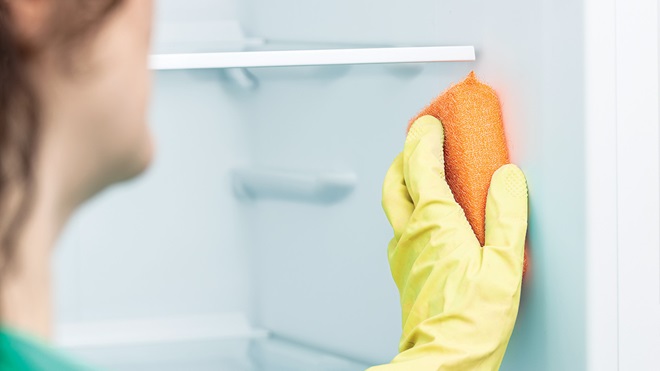Need to know
- Wipe up any spills as they happen to make your life easier in the long run
- Food absorbs odours, so use a mild unscented detergent when cleaning inside your fridge
- To combat nasty odours, place an open container of baking soda in the fridge to absorb the smells over a week or so
No one likes opening the fridge to a whiff of something gone wrong, so every once in a while you'll want to give your fridge the once-over to make sure it's clean and running at its best. Read on for our fridge cleaning and maintenance advice to find out what you should be doing (and how often you should be doing it).
If you're worried you can't bring your fridge back from the brink and are keen to replace it, our fridge buying guide explains what to look for to make sure you get the right fridge for your household.
On this page:
- Tips for keeping your fridge clean
- How to clean and maintain your fridge
- How to get rid of smells in a fridge
Tips for keeping your fridge clean
Most manufacturers will tell you to turn off your fridge before cleaning, so it's best to clean when your food supply is low.
Because food absorbs odours, use a mild unscented detergent and lukewarm water with a soft cloth on the inside and outside of the fridge (try not to use any abrasives as this can damage your fridge). Make sure all parts, including the seals, are thoroughly dried after washing and avoid wetting any controls or electronic areas.
Thoroughly wiping up any spills as they happen will help in the long run, as will wiping clean any jars, bottles or containers that have become sticky or grimy.
How to clean and maintain your fridge
Every use
- Make sure your fridge's contents are loaded in a way that lets air circulate. Not sure on the best way to do this? Read our tips on how to keep food fresher for longer (and cut down on your energy bills in the process).
- Check that the door is properly closed. This is especially true for the freezer door – otherwise your food will thaw out, your energy use will go through the roof, and it will cause frost to form, even in a frost-free freezer.
Weekly
- Clean external surfaces with either soapy water, an all-purpose cleaner or a soft damp cloth.
- Glass finish or stainless steel fridges can also be wiped down with methylated spirits or window cleaner. But check the manual first, as some surfaces that look like stainless steel aren't actually made from stainless steel.
- Wipe down door seals and contact points with a soft damp cloth to remove grime and ensure a good seal.
Monthly
- Pull out the shelves and crisper and give them a clean with warm soapy water. This is also a good time to audit your fridge contents and bin anything that's gone bad.
Every change of season
- Roll your fridge out of its enclosure and clean behind and under it.
- Check internal temperatures with a thermometer and adjust the controls to compensate for changes in ambient temperature. This is especially important if your fridge doesn't adjust well to changes in the outside temperature, like the change from winter to summer.
Annually
- For old or retro style fridges, clean and dust the external condensers at the back of the fridge.
- If water is leaking from under your fridge, check and clear the drainage or evaporation pans. Something else going wrong? Find out more about common fridge problems and how to solve them.
- For manual defrost fridges and chest freezers, defrost and clean the freezer compartment once more than half a centimetre of ice has formed. Not sure how to do this? Learn more about how you can manually defrost your freezer.
- For frost-free freezers, icing up is a sign that either the door's not closing properly or the door seal needs replacing.
- Audit the contents of your freezer and dispose of anything unidentifiable or that predates civilisation.
- Check and replace your water filter if necessary.
- Check the door seals for wear and replace if necessary.
How to get rid of smells in a fridge
Whether it's a forgotten takeaway container or a mysterious brown liquid lurking at the bottom of your crisper where you once had carrots, nasty fridge odours never make for a pleasant experience no matter what their source. Try these steps to get to the bottom of any bad smells in your fridge.
- Check if anything you've put in the fridge has spilled or started to spoil, or if any food items haven't been covered properly.
- Some containers and wrappers, such as cardboard, can cause smells or react with food to create smells.
- If you can't find the culprit, try putting an open container of baking soda in the fridge to absorb the smells over a week or so.
We're on your side
For more than 60 years, we've been making a difference for Australian consumers. In that time, we've never taken ads or sponsorship.
Instead we're funded by members who value expert reviews and independent product testing.
With no self-interest behind our advice, you don't just buy smarter, you get the answers that you need.
You know without hesitation what's safe for you and your family. And our recent sunscreens test showed just how important it is to keep business claims in check.
So you'll never be alone when something goes wrong or a business treats you unfairly.
Learn more about CHOICE membership today
Stock images: Getty, unless otherwise stated.



